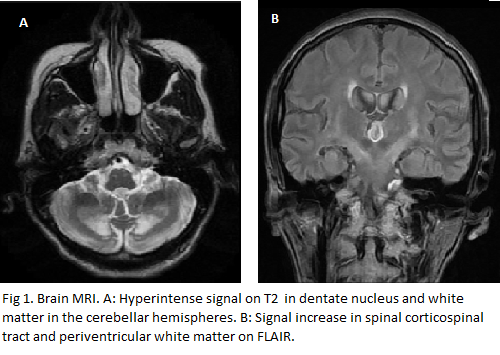Session Information
Date: Tuesday, June 6, 2017
Session Title: Rare Genetic and Metabolic Diseases
Session Time: 1:45pm-3:15pm
Location: Exhibit Hall C
Objective:
To describe the case of Cerebrotendinous xanthomatosis (CTX) without tendon xanthoma, highlighting the diagnostic challenge due to its rarity, as well as the importance of neuroimaging.
Background: CTX is a rare autosomal recessive disease caused by mutation in the CYP2A1 gene, encoding the mitochondrial enzyme sterol 27-hydroxylase. This enzyme participates in bile acid synthesis and cholesterol and other sterols metabolism, so that its reduction results in cholesterol and cholestanol deposit in several tissues, especially tendons, nervous system and crystalline lens.
Methods: A 52 year-old Caucasian woman that developed seizures and delayed psychomotor development at the age of 5. At the age of 24 she underwent cataracts surgery. One year later she developed dystonic movements (predominantly craniocervical), as well as dysarthria, dysphagia and ataxia. There was progressive worsening of motor function, so that she became wheelchair-bound at the age of 30 and bedridden at 49. She has had no effective interaction for the past 3 years and she is under exclusive gastrostomy feeding.
Results:
Laboratory workup revealed cholestanol of 19.6 mmol/L (Reference: 2-12 mmol/L) increased cholestanol/cholesterol rate of 4.55 (Reference: 0.16 +/- 0.05) and increased cerebrospinal fluid albumin of 24.4 mg dL (Reference: up to 3.5). Brain MRI showed diffuse cortical atrophy, multiple signal changes affecting the posterior limb of the internal capsule, brain peduncles, pontine median raphe, upper and middle cerebellar peduncles, medullary pyramids and cerebellar white matter. Spinal MRI revealed extensive longitudinal signal alteration (hyperintensity on T2) of the posterior and lateral funiculi and corticospinal tracts of the cervical and thoracic spinal cord. Achilles tendon MRI was normal. Genetic test with analysis of CYP27A1 gene revealed that the patient is a homozygous carrier of a late nonsense mutation, which is diagnostic of CTX.
[Figure 1]
Conclusions: Early suspicion of rare and potentially treatable diseases is of great importance in medical practice because it changes the natural history of the disease and, consequently, the clinical outcome of the patients. The neuroimaging is essential in the diagnostic investigation of XCT. It should be noted that up to 30% of patients with XCT do not present with tendon xanthomas, as in the case reported.
References: [1] Rosafio, F.; Cavallieri, F.; Guaraldi, P.; Taroni, F.; Nichelli, P. F.; Mandrioli, J. The wide spectrum of erebrotendinous xanthomatosis: Case report of a rare but treatable disease. Clinl Neurol Neurosurg 143 (2016). 1-3. [2] Preiss, Y.; Santos, J. L.; Smalley, S. V.; Maiz, A. Cerebrotendinous xanthomatosis: physiopathology, clinical manifestations and genetics. Rev Med Chile 142 (2014). 616-622.
To cite this abstract in AMA style:
S. Souki, L. Vasconcellos, M. Spitz, J. Pereira, V. Marussi, A. Carrié, P. Couvert. Cerebrotendinous xanthomatosis without tendon xanthoma: a diagnostic challenge. [abstract]. Mov Disord. 2017; 32 (suppl 2). https://www.mdsabstracts.org/abstract/cerebrotendinous-xanthomatosis-without-tendon-xanthoma-a-diagnostic-challenge/. Accessed December 7, 2025.« Back to 2017 International Congress
MDS Abstracts - https://www.mdsabstracts.org/abstract/cerebrotendinous-xanthomatosis-without-tendon-xanthoma-a-diagnostic-challenge/

